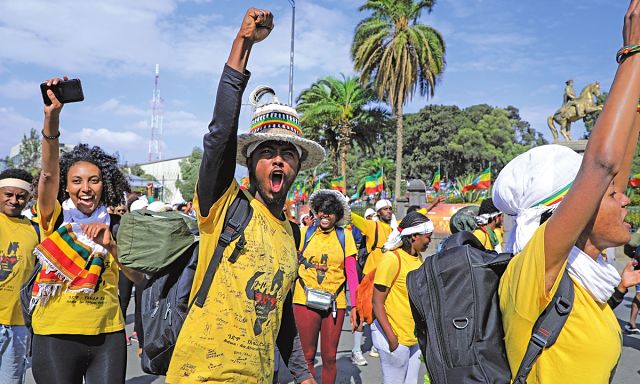 Ethiopians are fiercely proud of the fact that they were never colonized, having repelled foreign invaders to remain independent while the rest of Africa was carved up by European powers. Ethiopians' spirit of independence is expressed in many unique ways: use different clocks and their own calendar. It was the first African state admitted to the League of Nations and United Nations, and the capital Addis Ababa is the headquarters of the African Union. (Photo: Adwa Victory celebration in Addis on March 2, 2021/VCG)
Ethiopians are fiercely proud of the fact that they were never colonized, having repelled foreign invaders to remain independent while the rest of Africa was carved up by European powers. Ethiopians' spirit of independence is expressed in many unique ways: use different clocks and their own calendar. It was the first African state admitted to the League of Nations and United Nations, and the capital Addis Ababa is the headquarters of the African Union. (Photo: Adwa Victory celebration in Addis on March 2, 2021/VCG)
AFP
Africa’s second-largest nation by population, with 110 million people from dozens of ethnic groups, Ethiopia, is among the world’s oldest countries and has dominated the Horn of Africa for centuries.
Here are five things to know about Ethiopia, where results issued Saturday showed Prime Minister Abiy Ahmed’s ruling party winning a landslide victory in a June election.
Millennnia old
Like the Greeks and Romans, the Axumites in what is modern-day Ethiopia and Eritrea, were regarded in the first century AD as one of the world’s great early civilizations.
Powerful and prosperous, this kingdom traded with Europe and Asia, and conquered lands in Africa and Arabia. The Axumites adopted Christianity in the early fourth century, before most of Europe, and devised their own alphabet.
Centuries on, this ancient script is still recited by Orthodox priests in stone-hewn churches and hilltop monasteries, while Axum, many Ethiopians believe, is the final resting place of the Ark of the Covenant.
Ethiopia’s natural history, meanwhile, stretches back much, much further.
The fossilized remains of Lucy, an ancient ancestor of modern humans who roamed the Earth 3.2 million years ago, were discovered in Ethiopia, along with other early hominid bones and some of the oldest-known stone tools.
Fiercely independent
Ethiopians are fiercely proud of the fact that they were never colonized, having repelled foreign invaders to remain independent while the rest of Africa was carved up by European powers.
From the late 13th century until 1974 – some 700 years – Ethiopia was ruled by a royal dynasty that considered itself directly descended from King Solomon and the Queen of Sheba.
The last emperor, Haile Selassie, was overthrown by the communist Derg regime. A defining figure in modernizing Ethiopia, Haile Selassie was also believed to be a messiah by Rastafarians in faraway Jamaica.
An Italian invasion was rebuffed in the late 1800s, and Mussolini’s forces briefly occupied the country beginning in 1936, but were expelled five years later by Ethiopian forces.
Ethiopians’ spirit of independence is expressed in many unique ways. They use different clocks, with sunrise marking the start of a new day, and refer to their own calendar, which has 13 months and is seven years behind the Western one.
It was the first independent African state admitted to the League of Nations and United Nations, and the capital Addis Ababa is the headquarters of the African Union.
Diverse and faithful
Ethiopia is divided into 10 states along ethnic and linguistic lines. They vary greatly in territory and population, though each enjoys a level of self-rule from Addis Ababa.
The Oromos are the largest ethnic group, and include among their number the prime minister. Amharas are the second largest, while other sizeable minorities include the Somalis and Tigrayans.
The Sidama people overwhelmingly backed the creation of Ethiopia’s newest region in a referendum in 2019, spurring bids for autonomy from other groups particularly in the multi-ethnic southern part of the country.
Ethiopia remains mainly Christian, while about one-third of the country is Muslim, with regions in particular near Djibouti and Somalia predominantly following Sunni Islam.
A small Jewish community exists in Ethiopia, though most were brought to Israel in the 1980s and early 1990s, sometimes by extraordinary means. The covert mission “Operation Solomon” airlifted some 15,000 Ethiopian Jews to Israel over 36 hours in 1991.
Rising economy
Ethiopia is one of Africa’s fastest-growing economies, with industry and services driving its expansion, but faces considerable hurdles including huge debt payments. It hopes to reach lower-middle income status by 2025.
Most of the population is engaged in agriculture and about a quarter of Ethiopians live in poverty. Hunger remains a constant threat in a country no stranger to famine.
In recent years the government has moved to liberalize the economy, vowing to open state-run industries to foreign investment, including Ethiopian Airlines, the largest carrier in Africa.
Ethiopia is landlocked, having lost its gateway to the Red Sea when Eritrea gained independence in 1993.
Regional clout
Ethiopia is blessed with a major tributary of the Nile, on which it has constructed an enormous $4.6 billion dam it sees as crucial for alleviating poverty, electrifying rural homes, and improving the lives of millions.
But the Grand Ethiopian Renaissance Dam is fiercely opposed by Sudan and Egypt, two countries downstream who argue the mega-project threatens to cut off their own supplies of life-supporting Nile waters.
The war in Tigray, in Ethiopia’s north, saw Eritrean troops cross the border to join the fray, while Sudanese and Ethiopian forces have clashed over a strip of fertile farmland along the border claimed by both countries.
—
Join the conversation on Twitter and Facebook.

























